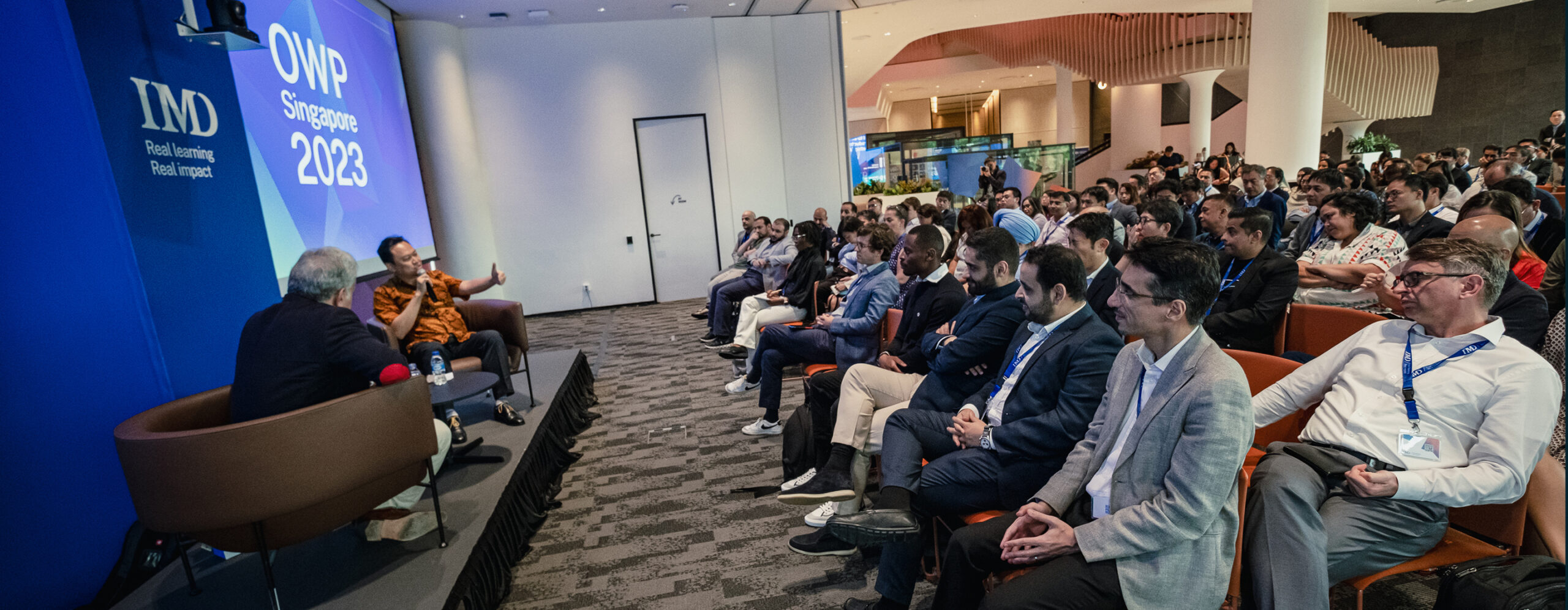Layoffs, mergers, and restructuring present major changes to companies. Even simple changes like new systems or a new product can represent a change. All of this change has the potential to create massive uncertainty and anxiety at all levels of the company.
But it doesn’t have to.
No matter what type of change your company is facing, as business leaders, it’s up to you to lead the change.
This is where organizational change management comes into play.
- What is organizational change management (OCM)?
- What are the key components of organizational change management?
- Why is organizational change management important for businesses?
- What are the tips for successful change management?
- How to successfully manage, accelerate, and embed change through IMD?
What is organizational change management (OCM)?
Organizational change management, or OCM, is the systematic approach to effectively managing and navigating an organizational transformation or transition.
OCM involves planning, communicating, and engaging stakeholders to ensure the smooth adoption of new processes, technologies, or cultural shifts.
There are many reasons to adopt this methodology when contemplating a major change within your organization.
For starters, investing in OCM minimizes employee resistance, fosters employee buy-in, and drives successful change implementation for enhanced organizational performance and growth.
When it comes to large-scale changes, OCM can help companies avoid …
- Going over budget
- Missing important milestones
- Project delays
- Losing current and future customers
What are the key components of organizational change management?
Let’s now look at the components of organizational change management and how they contribute to positive outcomes.
1. Communication and stakeholder engagement
Change is hard enough – but it’s even harder when you’re in the dark during big changes.
Effective communication and engagement show respect to both your key stakeholders and your employees. Employees are less likely to resist changes when they feel respected and supported.
How do you do this?
It starts with delivering clear messaging. Open up the initial dialogue by explaining the reasons for the change, including the risks of not changing. Be as transparent as possible, letting people know pertinent details that will affect them moving forward.
Open up two-way communication and collaboration, where you listen to people’s concerns and address those concerns in a meaningful way.
These steps will support a smooth transition and successful change implementation.
2. Change readiness and planning
Effective organizational change management must include an assessment of change readiness and change planning.
An organization must analyze the business environment, processes, capabilities, resources, and company culture to assess change readiness. In doing this, they assess potential risks in implementing change and how to best mitigate it.
Once the company has assessed change readiness, it can begin change planning. In this process, the company identifies obstacles and gaps in the process. This allows business leaders to create a plan for overcoming challenges in the change implementation process.
These are essential steps in your business strategy. After all, being proactive with your readiness assessment and planning minimizes risks and increases the chances of succeeding with your change management strategy.
3. Training and development
Training is important at all levels of your organization, especially when implementing change initiatives.
On your human resources and management team, training can help leaders within your organization manage and drive changes successfully.
Among your employees, training helps them learn new skills that add to their value within the company. These training programs can help them navigate new business processes, new technology, and the new organizational structure with confidence.
Such training will help all company employees adapt more quickly to the changes and contribute to successful outcomes.
4. Change implementation and monitoring
No matter how much planning you do, there will come a time for action. Eventually, you must implement your changes.
That’s when monitoring comes into play. Track change progress and make adjustments as you see a need – after all, nothing’s perfect on the first attempt.
Managing the implementation process ensures the change remains on track and you reach your desired results.
“Change is the law of life and those who look only to the past or present are certain to miss the future”.
— John F. Kennedy
Why is organizational change management important for businesses?
Let’s examine why investing time and resources into organizational change management is important.
- Increased employee engagement: Managing organizational change is about more than just sending out company-wide memos.
It’s about getting people at all levels of your organization involved and engaged in the changes taking place.
The more you engage your employees and make them feel like part of the change process, the more likely they will support the change and successfully implement it. - Improved communication: Communication is one of the pillars of the change management model – it’s also one of the biggest benefits of a good change management strategy.
The entire change process becomes easier when good communication exists between employees, leaders, top management, and other key stakeholders.
After all, healthy communication reduces confusion and uncertainty. In turn, people at every organizational level will begin to trust and support the changes that are taking place. - Reduced resistance to change: Change is always a little hard and can create resistance, which slows progress. Employee resistance takes many forms – employees may actively not participate or resist the efforts of change leaders. This can hinder project management, productivity, and staff morale.
However, the right change management skills and methodologies can help organizations overcome this resistance.
For instance, giving employees the information and support they need can diffuse their resentment of change and reduce friction. As employees come to understand the reasons for the change and even how it will benefit them, they often begin to support the changes. - Increased productivity: When implemented correctly, organizational changes bring improvements in the form of updated processes, new systems, and streamlined work.
This creates a more coordinated and healthy work environment and makes employees more productive.
In addition, a supportive and communicative team environment motivates employees to be more engaged in their tasks. This contributes to greater productivity. - Improved customer satisfaction: Everything in your organization eventually trickles down to the customer – this can be both good and bad.
Let’s talk about how positive change management can lead to a better customer experience.
Leading organizational changes in a positive and supportive way creates a sense of security and stability in your employees.
When employees feel more secure and confident in their job, your organization can operate more efficiently and effectively. This can lead to better-quality products and services and minimize mistakes and negative outcomes that impact your customers.
What are the tips for successful change management?
Here are a few ways to make your change management even more successful:
- Start small. Don’t overwhelm your employees with big changes all at once. Whenever possible, start with small, manageable changes. Once they’ve adapted to those changes, introduce additional, bigger changes.
- Communicate. Ensure your employees and team members fully understand the upcoming changes and how they will impact them, and listen to their fears and concerns so you can address them.
- Be patient. Even when positive, change is never easy. Your employees may go through a rollercoaster of emotions, from uncertainty to fear. Be patient and reassure them as much as possible.
- Be flexible. Be ready to adapt your strategy when you see your employees experiencing a hard time. Being flexible and ready to yield from time to time can create employee loyalty.
- Celebrate successes. Teamwork is at the core of successful change management – nurture that teamwork by encouraging your team. Reward your team and individual employees who go above and beyond in their duties.
- Be a real leader. From managers to executives, your leadership team should be ready to lead. This means setting an example among their team, being accessible to them throughout the process, and being supportive.
How to successfully manage, accelerate, and embed change through IMD?
Change is inevitable in every company – the status quo doesn’t last forever. But no matter which types of organizational change your company faces, having a change strategy in place will help everything go smoother.
Ready to deepen your understanding of organizational change management? Enroll in IMD’s online Change Management course and take charge of managing, accelerating, and embedding change.
Gain the knowledge and skills to engage minds, hearts, and behaviors, and design an effective change process within your organization. This program empowers you to envision and mobilize change initiatives, so you can apply your learnings directly to real-world projects.
Explore change management from multiple perspectives, integrating the individual and organizational, rational and emotional, and people and processes. This holistic approach will equip you with the tools to inspire, mobilize, and embed change with confidence and success.
Take the leap and enroll in the Change Management course from IMD today.





